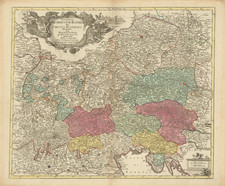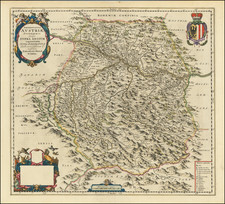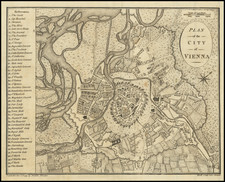Vienna After Construction of the Ringstraße
Finely executed plan of Vienna, offering a detailed perspective on the architectural and urban changes in Vienna during the 19th century.
Architectural and Urban Changes: 1800-1900
During the 19th century, Vienna underwent significant transformations in its urban planning and architectural design. The early 1800s saw a city constrained by medieval fortifications, but the decision to demolish the city walls in 1857 led to the development of the Ringstraße, an elegant boulevard that encircles the historic Innere Stadt district of Vienna.
The Ringstraße era is synonymous with grand and monumental buildings that represent various architectural styles, including Neo-Gothic, Neo-Renaissance, and Neo-Baroque. These styles coalesce to form a unique urban landscape that celebrates Vienna's rich cultural heritage.
Some notable structures that were built during this period include:
- The Rathaus (City Hall): An example of Neo-Gothic architecture, completed in 1883.
- The Vienna State Opera: A Neo-Renaissance building inaugurated in 1869.
- The Burgtheater: Another Neo-Renaissance marvel that opened in 1888.
The plan includes the burgeoning suburban districts, reflecting the city's expansion and the integration of previously independent municipalities. New roads, bridges, and public transportation facilitated the growing city's connectivity. The architectural character of the outer districts was typically more modest and functional compared to the grandeur of the Ringstraße buildings but no less important in shaping the city's character.
At the bottom right, a text box translates as follows:
For the explanation of the new numbering in the 10 districts of Vienna. Each street or lane has its own numbering, which starts with 1. and on this side, all odd, on the other side, starting with 2, contains all even numbers. The public squares are numbered in a circle with consecutive numbers in arithmetic order. Therefore, where in some places on the plan, for reasons of clarity, a cross (x) is placed instead of the number, this arises from the sequence of even or odd numbers by itself.
This text provides instructions for understanding the numbering system used in the map, detailing how streets, lanes, and public squares are numerically ordered.
The 1878 plan of Vienna captures a city in transformation, reflecting the ambitious urban planning and architectural achievements of the 19th century. The elegant Ringstraße, monumental public buildings, and newly integrated suburbs are testament to Vienna's emergence as a modern, cosmopolitan city. This map serves as both an artifact and a guide to understanding the complex and rich urban fabric of Vienna during a period of significant change and growth.














![[ Holy Roman Empire, Poland, Baltic, etc. ] Germania VI Nova Tabula (First state!)](https://storage.googleapis.com/raremaps/img/small/94645.jpg)
![[Vienna] Prospect und Grund Riss der Kayserl Residenz-Stadt Wien . . .](https://storage.googleapis.com/raremaps/img/small/81235.jpg)
![[ Holy Roman Empire ] S. Imperium Romano-Germanicum oder Teutschlenad mit Seinen Angrantzenden Konigreichen und Provincien,...](https://storage.googleapis.com/raremaps/img/small/98433.jpg)